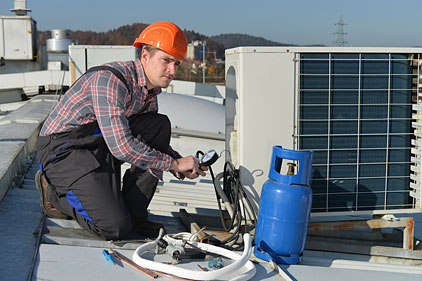 For newer technicians on the job, here are a couple of HVAC service tips about leak testing and evacuating after repairing a system.
For newer technicians on the job, here are a couple of HVAC service tips about leak testing and evacuating after repairing a system.The best way I've found to leak test a system is to pressurize it with nitrogen to about 125 psi, check the system with a bubble type leak detector, then leave it pressurized overnight.
I'll leave a pressure gauge connected to the system so I can check pressures the next day without having to mess around with any Schraders or isolation valves.
I'll connect the gauge with brass fittings and copper tubing, but I won’t use the hoses from a gauge manifold set.
If the nitrogen pressure holds overnight, I can be pretty sure there’s no leak in the system.
After that I’ll vent the nitrogen, and hook up a vacuum pump.
I use copper tubing, put an isolation valve on the vacuum pump and at both access ports, and I find one more location to attach my micron gauge, also with an isolation valve.
Then I vacuum the system until the micron gauge reads below 500 microns.
What I do is leave the isolation valve on the micron gauge closed during the evacuation, except for when I want to check the micron level.
When I want to check the micron reading, I open the isolation valve and wait for about a minute, then close the isolation valves at the vacuum pump and access ports, and turn off the vacuum pump.
Depending on the size of the system you’re repairing on your HVAC service call, it might take a couple of minutes for the micron reading to steady out.
If the reading steadies out above 500 microns, I close the isolation valve and continue evacuating.
If the reading steadies out below 500 microns, I close the isolation valve, wait for 10 or 15 minutes, then open the isolation valve again and check the reading.
If the reading has stayed the same, I consider the evacuation complete, and start the re-charging procedure.
If the reading has risen above 500 microns, I close the isolation valve and continue evacuating until the micron reading will stay below 500.
Occasionally an isolation valve, flare nut connection, or micron gauge will go bad and start leaking during an HVAC service call, so keep this in mind, and leak test the equipment on a regular basis.
If your system held 125 psi of nitrogen overnight but won’t vacuum down to below 500 microns, carefully check your vacuum pump and all evacuation connections to the system.
Publication date: 12/9/2013
Want more HVAC industry news and information? Join The NEWS on Facebook, Twitter, and LinkedIn today!







